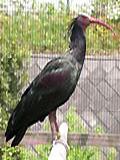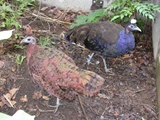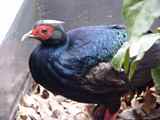- Yokohama-shi Top Page
- Living and Procedures
- Community Development and Environment
- Green park
- Zoos and Botanical Gardens
- Preservation and Research Center, City of Yokohama
- Animals raised in Preservation and Research Center, City of Yokohama
- Birds raised in Preservation and Research Center, City of Yokohama 2
Here's the text.
Birds raised in Preservation and Research Center, City of Yokohama 2
Last update date April 1, 2024
Introduction of Walldrapp Ibis Congo Peacock Vietnamese Pheasant
I would like to introduce Walldrapp Ibis, Congo Peacock and Vietnamese Pheasant, which are bred in Preservation and Research Center.
Walldrapp Ibis Waldrapp Ibis

<scientific name> Geronticus eremita
The total length is 70-80cm, the body is green and glossy black, the small rain cover is bronze purple, and the beak and legs are red. As it grows, the wings of the head fall off and become bald, and the neck wings become longer. Males are slightly larger than females, but there is no apparent difference in appearance in male and female. It lives in relatively dry areas in small flocks and feeds on small animals such as grasshoppers. A colony nests on the rock shelf of a high cliff, and male and female jointly carry out incubation and breeding chicks. The clutch size is 2 to 4. The chicks hatch in about 28 days and nest in 40-50 days.
Until the 17th century, it was distributed to Western Europe, but now it only inhabits only a small number of Turkey and Morocco, and is designated as an endangered species. In Turkey, only 55 birds are left in Birecik in the eastern part near the border with Syria and around 220 birds are left in Souss-Massa National Park in Morocco, and the population that inhabited Algeria is considered to be close to extinction.
On the other hand, under breeding, about 1,000 birds are bred around the world, including European zoos, and some institutions are planning to return to the wild.
Congo Peacock Congo Peacock

<scientific name> Afropavo congensis
Congo Peacock is a group of peacocks that live only in tropical rainforests at an altitude of 1,200 m from the lowlands of the Republic of the Congo and the Democratic Republic of Congo near the central African equator.
It has a total length of 60cm to 70cm and a weight of 1,100g to 1,500g, almost the same size as male and female. The male has a white and long crown, the naked throat skin is red, the chest to the lower surface is covered with dark purple feathers, the upper surface is dark green, the tip of the tail feather and the tip of the middle rain cover There is a blue metal luster. There are no long and splendid feathers as seen in other peacocks, Great Argus and Polyplectron, or beautiful eyeballs. Females are not as long as males, but have brown crowns, the throat is red, the chest to the lower surface is covered with brown feathers, and the back is shiny green.
They live mainly on the ground during the day and sleep on trees at night. It eats various plants, insects, including fruits, seeds, etc.
There is no breeding season in the wild, and breeding is said to depend on rainfall conditions. When the estrus begins, the male stands up a tail feather, spreads a white crown, and approaches the female while shouting with a gruguru. The nest is made on the ground or on a tree, and lays 2-3 eggs in one clutch, up to 6 eggs. The incubation is performed only by females, and the chicks hatch around 28 days.
male and female will cooperate in raising chicks. Hinas have wings from birth, and can gradually fly five days after birth. The chicks have yellow and brown mottled patterns, and can't distinguish between males and females, but three months after birth, the feathers change and the feathers of each male and female.
Congo Peacock was discovered relatively new in 1936, and until then peacocks were believed to be distributed only in Asia and not in Africa, so it surprised the world's ornithologists at that time. It is a rare animal that has been protected by law early on in the field and still requires special permission for capture. It began to be bred in the United States in 1949 and in Western Europe in 1957, and currently about 100 birds are bred around the world. At the Royal Antwerp Zoo in Belgium, which governed the Democratic Republic of Congo, the Royal Antwerp Zoo manages the International Studbook in Congo Peacock and has established a fund to focus on the bred conservation.
Only Preservation and Research Center, City of Yokohama is bred in Japan.
Vietnamese Pheasant Vetnamese Pheasant

<scientific name> Lophura hatinhensis
It is distributed only in very limited areas of central and northern Annamite Range in central Vietnam.
Total length of 58-65cm, weight of about 1,100g. Males are dark blue with deep purple gloss throughout the body and have short white crowns. The red skin is naked around the eyes and spreads this skin greatly during courtship. Females are brown on the whole, and the underside, windkiri feathers, and tail feathers are blackish. The naked part of the skin around the eyes is red, but not as large as males. The male central tail feathers are white, distinguished from the Edwards's Pheasant (Lophura edwardsi), which inhabits the same central part of Annamite Range, but females do not have this characteristic and cannot be externally distinguished from Edwards's Pheasant.
The habitat is a secondary forest at an altitude of 50 to 200m and a lowland covered with evergreen trees. It prefers the area along the river where plants grow, and feeds seeds, fruits, insects, etc. The clutch size is 4 to 7 eggs, the incubation period is 21 to 22 days. The chicks have brown on the top and pale yellowish brown on the face and underside.
It was once regarded as a variant of the Edwards's Pheasant or a completely separate independent species, but it has recently been treated as a variant of the Edwards's Pheasant because of insufficient evidence.
Edwards's Pheasant is designated as Critically Endangered (CR) by the Red List of the International Union for Conservation of Nature.
Inquiries to this page
Yokohama Green Environment Bureau Park Green Space Division Zoo Division Preservation and Research Center
Telephone: 045-955-1911
Telephone: 045-955-1911
Fax: 045-955-1060
Email address: mk-hansyoku@city.yokohama.lg.jp
Page ID: 260-798-970







